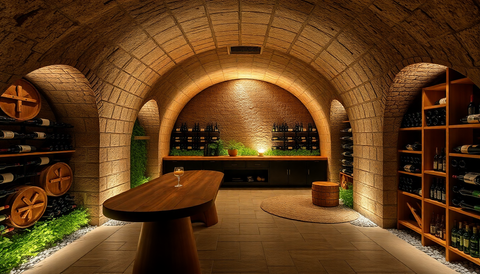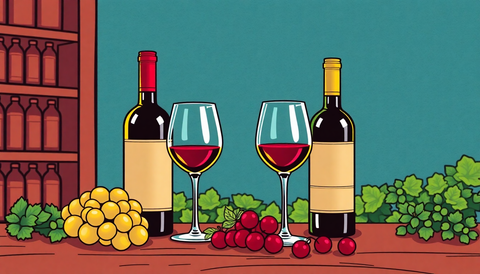The Enduring Legacy of the Wine Barrel
For centuries, the humble wooden barrel has been an indispensable partner in the journey of wine from grape to glass. Far from being mere storage vessels, wine barrels play a crucial role in shaping the flavour, aroma, texture, and aging potential of wine.
Whether you're a seasoned sommelier or a curious wine enthusiast, understanding the nuances of barrel aging unlocks a deeper appreciation for the complexities of your favourite vintages. In 2025, the traditional methods of barrel making and aging continue to be revered, even as innovation subtly shapes the industry.
Oak: The King of Wine Barrel Wood
When we talk about wine barrels, we're almost invariably talking about oak. Oak's unique properties make it the ideal material for winemaking for several key reasons:
- Impermeability: Oak is naturally watertight, preventing precious wine from leaking out.
- Porosity: While watertight, oak is also porous enough to allow a small, controlled exchange of oxygen. This micro-oxidation is vital for softening tannins, stabilising colour, and developing complex flavours over time.
- Flavour Contribution: Oak imparts a range of desirable flavours and aromas to wine, including vanilla, toast, spice, coffee, and smoke. These characteristics vary depending on the type of oak, its origin, and how it's toasted.
- Tannin Structure: Oak contributes its own set of tannins, which can add structure, body, and aging potential to the wine.
The Two Main Players: French and American Oak
While other woods like chestnut and acacia have been used historically and in specific regions, French and American oak dominate the modern winemaking world. Each offers distinct contributions:
French Oak
- Origin: Primarily sourced from forests like Limousin, Nevers, Allier, and Tronçais in France.
- Grain: Tends to have a finer, tighter grain.
- Flavour Profile: Imparts more subtle, complex, and integrated flavours. Notes of spice (clove, nutmeg), floral characters, and a delicate toastiness are common. It's often described as more elegant and refined.
- Cost: Generally more expensive due to slower growth, tighter grain requiring less wood per barrel, and higher demand.
American Oak
- Origin: Typically sourced from white oak species in the United States.
- Grain: Has a coarser, more porous grain.
- Flavour Profile: Contributes bolder, more assertive flavours. Prominent notes of vanilla, dill, coconut, and a more pronounced toast are typical. It can add significant body and sweetness.
- Cost: Generally more affordable and readily available.
The Importance of Toasting and Charring
The way a barrel is treated before it's filled with wine significantly impacts its contribution. Toasting and charring are two critical processes:
Toasting
Barrels are heated from the inside, breaking down complex compounds within the wood. The level of toast (light, medium, heavy) determines the intensity of the flavours imparted. Lighter toasts contribute more subtle vanilla and sweet spice, while heavier toasts bring out smoky, coffee, and caramel notes.
Charring
Primarily used for spirits like whiskey, charring involves burning the inside of the barrel until it turns black. This process caramelises sugars in the wood and creates a charcoal layer that filters the spirit. While less common for wine, some winemakers might use lightly charred barrels for specific stylistic effects.
New Barrels vs. Used Barrels (Seasoned Oak)
The choice between a new barrel and a used one is a fundamental decision for winemakers:
New Barrels
- Impact: Offer the most intense oak influence. They contribute significant tannins, flavour compounds, and allow for greater micro-oxidation.
- Usage: Often used for wines intended for long aging and those that can benefit from robust oak character, such as high-quality Cabernet Sauvignon, Chardonnay, and Syrah.
- Cost: The most expensive option.
Used Barrels (Second, Third, or more fill)
- Impact: Have already imparted most of their primary oak flavours and tannins to previous wines. Their primary contribution is allowing for controlled micro-oxidation without adding overwhelming oak character. This is often referred to as "seasoning" the wine.
- Usage: Ideal for wines where the fruit character is paramount and oak is meant to be a subtle supporting player, or for wines that benefit from gentle aging. Many white wines, lighter-bodied reds, and wines from regions with a strong tradition of minimal oak influence utilise used barrels.
- Cost: Significantly less expensive than new barrels.
Beyond Oak: Other Barrel Considerations
While oak reigns supreme, other factors influence barrel aging:
- Barrel Size: Smaller barrels have a higher surface-area-to-volume ratio, meaning more wine comes into contact with oak and oxygen, leading to faster aging and more pronounced oak influence. Larger barrels (like foudres) offer a gentler, slower aging process.
- Barrel Age: As mentioned, older barrels contribute less oak flavour but still allow for beneficial micro-oxidation.
- Wood Origin & Cooperage: Even within French or American oak, variations in forest, tree age, and the specific cooper (barrel maker) can lead to subtle differences in the wood and the resulting wine.
- Alternative Aging Vessels: While barrels are traditional, winemakers also explore other vessels like stainless steel tanks (for preserving fruit purity), concrete eggs (for promoting lees stirring and micro-oxidation), and various sizes of wooden vats or tanks that may not be fully enclosed barrels.
The Barrel's Role in Wine's Evolution
Barrel aging is a meticulous process. Winemakers carefully select barrels based on the grape varietal, wine style, and desired outcome. They monitor the wine's progress, deciding when to rack (transfer the wine off its sediment) and how long to age it.
This symbiotic relationship between wine and wood allows the wine to mature, soften, integrate its components, and develop the complex tertiary aromas and flavours that distinguish truly exceptional vintages. In 2025, this respect for tradition, combined with a willingness to experiment, ensures that the art of barrel aging remains a vital and fascinating aspect of winemaking.




Comments (0)
There are no comments for this article. Be the first one to leave a message!